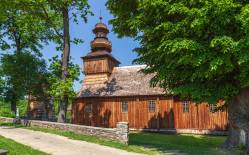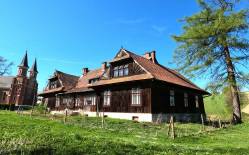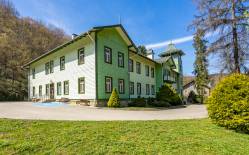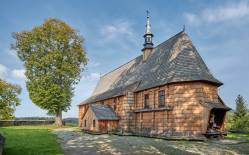Branch church of the Discovery of the Holy Cross and Christ Crucified was built in 1868, and then reconstructed in 1890. The vestibules added on that occasion have not been preserved.
The log church is not oriented towards the East. Inside it is a single-span structure; the chancel, enclosed with semi-hexagonal walls, is not separated from the nave. The front façade features a crucifix. The gable roof, clad with sheet metal, supports a hexagonal bell turret.
Inside there is a flat coved ceiling. Other features include neo-Baroque architectural wall paintings, pipe organ casing from 1869 and brick floor.
The neo-Baroque high altar from the 19th century comprises a crucifix from the 17th century, which is an object of veneration. Other furnishings include a stone holy water font from the 19th century, stained-glass windows from the 20th century with representations of Saint Therese and Our Lady of Częstochowa, a painting on the wall with a representation of the legend about the finding of the Holy Cross in 1926 at this location, and the Discovery of the Cross by St. Helen, from 1937.
According to the legend, the small church was built at a site where a figure of Christ on the Cross was dug out by a local farmer. Faced with the figure, the oxen pulling the plough stopped to kneel down. When they saw that, the peasant and his daughter bowed to Christ as well. Initially, they hang the cross on a nearby tree, but after some miraculous events took place the local people decided to build a church here. They say that the village was sometimes called Klękówka (“kneeling site”) by reference to the kneeling oxen.
At the back of the church there is a spring, commonly believed to be source of healing water. Originally it was located even closer to the church, next to the figure of St. John of Nepomuk. Yet, there was less and less water; the faithful blamed Jews from Rymanów and Iwonicz who would come here and collect water. It was said, the spring dried out after one of them washed in it.
Photo: Krystian Kłysewicz
Gallery
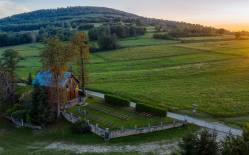
Recommended venues on the Trail



This website has been modernized with the financial support of the European Union under the Cross-Border Cooperation Programme Poland-Belarus-Ukraine 2014-2020. The responsibility for its content lies solely with the Podkarpackie Regional Tourism Board and cannot, in any case, be treated as a reflection of the position of the European Union, the Managing Authority, or the Joint Technical Secretariat of the Cross-Border Cooperation Programme Poland-Belarus-Ukraine 2014-2020.










